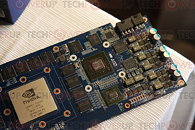- Joined
- Oct 9, 2007
- Messages
- 47,598 (7.45/day)
- Location
- Dublin, Ireland
| System Name | RBMK-1000 |
|---|---|
| Processor | AMD Ryzen 7 5700G |
| Motherboard | Gigabyte B550 AORUS Elite V2 |
| Cooling | DeepCool Gammax L240 V2 |
| Memory | 2x 16GB DDR4-3200 |
| Video Card(s) | Galax RTX 4070 Ti EX |
| Storage | Samsung 990 1TB |
| Display(s) | BenQ 1440p 60 Hz 27-inch |
| Case | Corsair Carbide 100R |
| Audio Device(s) | ASUS SupremeFX S1220A |
| Power Supply | Cooler Master MWE Gold 650W |
| Mouse | ASUS ROG Strix Impact |
| Keyboard | Gamdias Hermes E2 |
| Software | Windows 11 Pro |
While every NVIDIA GPU since GeForce 8 series, with over 256 MB of memory supports the CUDA GPU compute technology, and with it PhysX GPU acceleration, the prospect of dedicated GPUs for computing PhysX interests many, especially enthusiasts, after NVIDIA stopped production of the PhysX processor from erstwhile Ageia. EVGA first devised a graphics card that has a high-end GPU processing graphics, and a mainstream GPU dedicated to PhysX processing, with its GeForce GTX 275 Co-op. Building on the same principle, Galaxy designed an enthusiast-grade graphics card that uses an NVIDIA GeForce GTX 480 for DirectX 11 compliant graphics processing, while its sidekick on board is a 40 nm GeForce GT 240 GPU.
The GeForce GTX 480 sticks to specifications, complete with 1536 MB of GDDR5 memory across a 384-bit wide, while the GT 240 has its own 512 MB of GDDR5 memory across a 128-bit wide interface. Both GPUs share the system bus over an NVIDIA nForce 200 bridge chip, which gives both GPUs a PCI-Express 2.0 x16 link. The GTX 480 GPU packs 480 CUDA cores, and features the latest GPU technologies, including 3D Vision surround. Since it is independent from the GT 240, the GTX 480 can pair with three more of its kind for 4-way SLI, without affecting the functionality of the GT 240 in any way.



The GT 240 packs 96 CUDA cores, and is DirectCompute 4.1 compliant. It has enough compute power for offloading PhysX processing from the main GPU. Since the GT 240 in its standalone card form is very energy efficient by not requiring auxiliary power, its presence didn't affect the electricals of this card in any big way. The GTX 480 component seems to be powered by a 6+2 phase digital PWM circuit, while the GT 240 uses a simpler 2+1 phase PWM circuit. Power inputs remain 8-pin and 6-pin. More details as they emerge.
View at TechPowerUp Main Site
The GeForce GTX 480 sticks to specifications, complete with 1536 MB of GDDR5 memory across a 384-bit wide, while the GT 240 has its own 512 MB of GDDR5 memory across a 128-bit wide interface. Both GPUs share the system bus over an NVIDIA nForce 200 bridge chip, which gives both GPUs a PCI-Express 2.0 x16 link. The GTX 480 GPU packs 480 CUDA cores, and features the latest GPU technologies, including 3D Vision surround. Since it is independent from the GT 240, the GTX 480 can pair with three more of its kind for 4-way SLI, without affecting the functionality of the GT 240 in any way.



The GT 240 packs 96 CUDA cores, and is DirectCompute 4.1 compliant. It has enough compute power for offloading PhysX processing from the main GPU. Since the GT 240 in its standalone card form is very energy efficient by not requiring auxiliary power, its presence didn't affect the electricals of this card in any big way. The GTX 480 component seems to be powered by a 6+2 phase digital PWM circuit, while the GT 240 uses a simpler 2+1 phase PWM circuit. Power inputs remain 8-pin and 6-pin. More details as they emerge.
View at TechPowerUp Main Site







